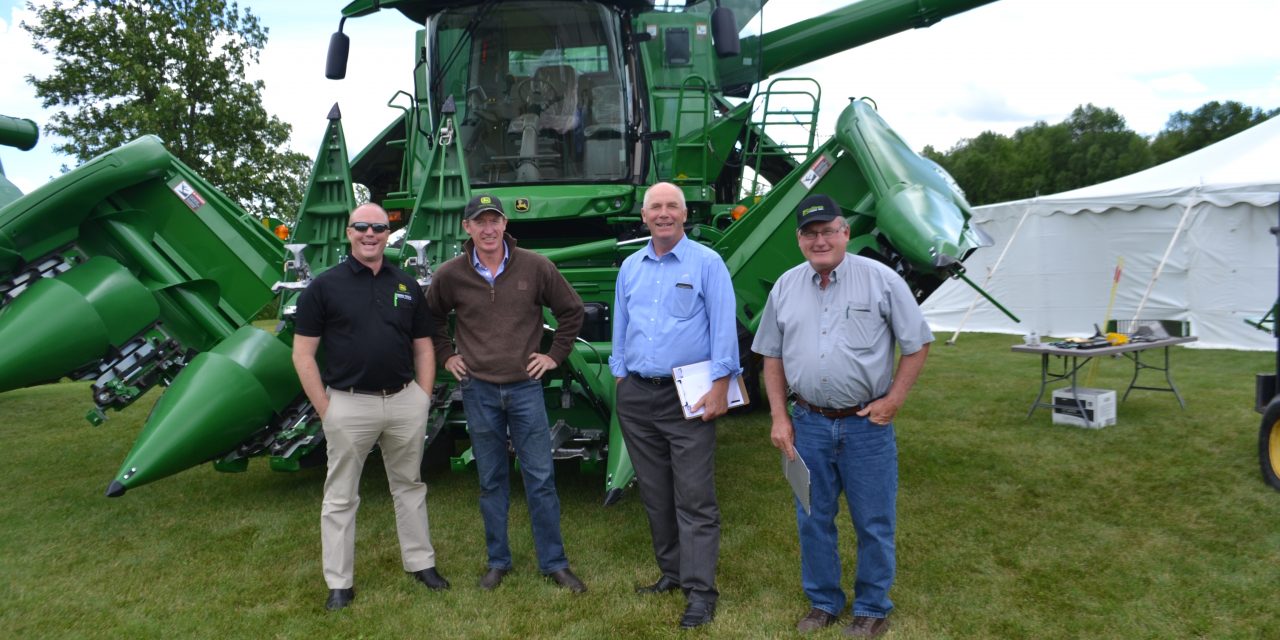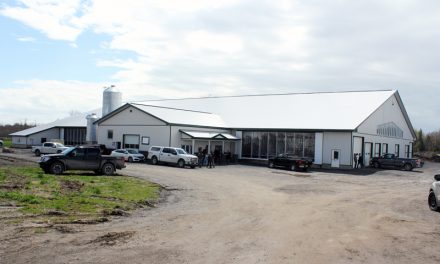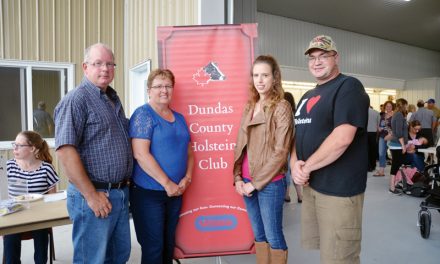Big ideas and big machines
From left, Bill McMillan, Stuart Adams, Greg Stewart and Paul Sullivan browse the combines on display at the Combine Clinic held in St. Isidore on June 21. The panelists discussed the future of agriculture during the hour-long panel and question period. Sawyer Helmer photo
by Kalynn Sawyer Helmer
AgriNews Staff Writer
ISIDORE – Green Tech, JLD-Lague John Deere dealers, held a combine clinic on Wed., June 21. The event hosted three workshops for attendees to explore and learn from. Topics from the workshops included, combine and header settings, calibrations, adjustments and key maintenance areas, new products from John Deere and Precision farming and technology, apps and the operations centre.
After lunch, three industry experts set up for a panel to discuss, “The future of the agriculture industry, facing a world population of nine billion people.” The panel was moderated by Regional Manager, Ontario, Bill McMillan.
On the panel were Agronomy Lead at Maizex, Greg Stewart, Agronomist and Sullivan Agro owner, Paul Sullivan, and Founder of Continuum Textiles Ltd., Stuart Adams.
McMillan opened the discussion by asking for the panel’s thoughts on “Eastern Ontario and Eastern Canada’s rank as an agricultural supplier in a global market.”
Stewart took the first bite of the topic suggesting, “When we look at per acre, we are pretty competitive. And when we look at corn yield per pound we are competitive in terms of efficiency. But we are a blister on the corn belt in global terms.”
Sullivan followed up by examining the health of the region’s soil, explaining that the area has not been cropped hard and has good soil production capacity. This means globally the soils have productivity as an advantage for corn. “It’s in the next four to five years that we need to maintain productivity by not beating up the soils. If we have control over the soils, we have production capabilities,” he added.
Canada and Eastern Ontario are well placed, said Adams. When looking at the access to ports and roadways, it is a competitive view. Despite not being able to produce almost year round like South American countries, Canada and Eastern Ontario are right on the boundary of the consumption market, “putting us in a good position for at least a few years,” added Adams.
McMillan then prompted the panel to discuss technologies that either are or will be available to help improve production.
Sullivan toyed with the idea that smaller farms in the area, “don’t have to be the biggest but the most efficient, every seed counts.” Technology can help achieve that efficiency. Not all of the panelists had the same opinion on technology. While Adams seemed to believe that it was a simple truth that technology equals efficiency and efficiency equals profit, Stewart took an arms-length approach.
“Fact-based farming rolls off the tongue nicely but is actually pretty challenging. You have to ask the questions – is this tech going to lower my costs and/or improve my yields?” insisted Stewart. Adams rebutted that while these questions need to be answered, technology is the device that can make that evaluation. “It’s not for everyone, but it gives you the tool to make evaluations,” he said. He added, with the help of vendors and tech providers, there is a partnership to help make the best decisions.
Sullivan chimed in that farmers should be open to “learning, accepting and using tech to make decisions. There used to be a lot of gut feeling decision in agriculture, but now, to stay in the movement upwards we need to pay more attention to things and document things.”
Stewart used the example of variable rate nitrogen technology as a classic problem. “If you don’t know your rates across the fields, it’s tough to pencil out the variable rate tech. You have to know the whole context of your field,” he continued.
One solution to that problem provided by Sullivan was getting farmers to collect data on tech like nitrogen. Planting one strip using the technology and monitoring the yields. It’s all about data collection and “having a basis about your fields before purchasing technology,” said McMillan.
McMillan then moved the discussion for the next stage of growth opportunity in the agriculture industry and what hurdles might accompany those opportunities. Of those opportunities, Stewart believes that seed and genetics will play a huge role in the future. “Not long ago 100 bushels was great; now though, you don’t even open your mouth if it doesn’t start with a two. Genetics are the future,” he said.
Sullivan agreed wholeheartedly with the value of understanding genetics, but also suggested that a farmer’s attitude can play a large role in the future. He continued that traditions and folklore are a big part of the agriculture world. Using this spring as an example, however, it was, “best to do less and that meant a lot if you had to work outside of your comfort level,” said Sullivan. He concluded that it was vital that farmers not get frustrated and keep their wits about them, “attitude might be more important than genetics.”
Adams expanded on Sullivan’s idea and encouraged farmers to adopt responsibility. “We are now in a very transparent society and we need to be prepared to change and learn,” he said. Without consumers there is no business and those consumers want to know where their food comes from and might have a say in changes to the way things are more traditionally done.
McMillan’s last topic prompted the panel to discuss whether there are markets that the region should be exploring. With new markets come challenges and risk, this was agreed.
“Do what you do and do it well,” said Adams. He didn’t want to discourage anyone from trying a new market but said it is an enormous undertaking to create change, so if you must then “do it with knowledge and ask questions.”
Stewart and Sullivan collaborated on the idea of cultivating a community for new markets. “Don’t go it alone. Get into a market that has some development to it. Find people to talk to, to help make it work,” said Stewart. Sullivan added, “We often don’t want to share our ideas, but if you do, your peers can really help you better the idea. Everyone is different but those perspectives are important. There is a lot at stake but also a lot of opportunity.”
McMillan then turned to questions from the crowd, where it was asked if it is possible to double yields in the next 20 years as have been done in the past 20 years.
“If you believe in trend lines, the doubling is in the system,” said Stewart. He continued, some of the solar brightening which is causing greater solar radiation may actually be improving yields. From the studied improvement in the corn belt of 100 per cent of that increase, Stewart said 27 per cent can be attributed to solar brightening. So his simple answer was, yes.
But what about paranoid consumers and aversions to certain ingredients? Adams added that at this time, “Consumers don’t actually know what we are doing. Once they do, there should be less resistance, provided you are doing it responsibly.”
Sullivan implored the crowd to talk. “Tell your neighbours you are trained to determine how much or little insecticide to use. Agriculture gets painted by the media. So talk, talk to people and educate, tell them why you do the things you do.”
Stewart agreed and added his idea, the battle had to be won on two fronts. “Science is in our favour but it doesn’t matter, it doesn’t change minds. It has to be won on a personal level. Unfortunately, it also has to be the spin. Agriculture will have to look to someone at a high level to spin the story in our favour,” concluded Stewart.
Green Tech, JLD-Lague holds their clinics every few years across Western Quebec and Eastern Ontario. The panel discussion addition was an interesting and thought-provoking end to the event which hosted a number of local farmers from the region.













